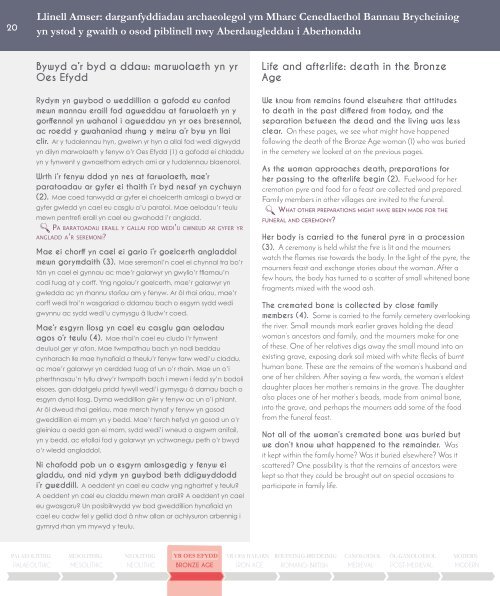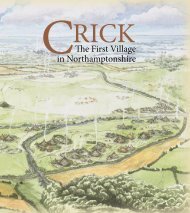Llinell Amser / A Line Through Time
Llinell Amser: darganfyddiadau archaeolegol ym Mharc Cenedlaethol Bannau Brycheiniog yn ystod y gwaith o osod piblinell nwy Aberdaugleddau i Aberhonddu -------------------------------------------------------------------------------------------------------------------- A Line Through Time: archaeological discoveries in the Brecon Beacons National Park during the installation of the Milford Haven to Brecon gas pipeline
Llinell Amser: darganfyddiadau archaeolegol ym Mharc Cenedlaethol Bannau Brycheiniog yn ystod y gwaith o osod piblinell nwy Aberdaugleddau i Aberhonddu
--------------------------------------------------------------------------------------------------------------------
A Line Through Time: archaeological discoveries in the Brecon Beacons National Park during the installation of the Milford Haven to Brecon gas pipeline
You also want an ePaper? Increase the reach of your titles
YUMPU automatically turns print PDFs into web optimized ePapers that Google loves.
20<br />
<strong>Llinell</strong> <strong>Amser</strong>: darganfyddiadau archaeolegol ym Mharc Cenedlaethol Bannau Brycheiniog<br />
yn ystod y gwaith o osod piblinell nwy Aberdaugleddau i Aberhonddu<br />
Bywyd a’r byd a ddaw: marwolaeth yn yr<br />
Oes Efydd<br />
Rydym yn gwybod o weddillion a gafodd eu canfod<br />
mewn mannau eraill fod agweddau at farwolaeth yn y<br />
gorffennol yn wahanol i agweddau yn yr oes bresennol,<br />
ac roedd y gwahaniad rhwng y meirw a’r byw yn llai<br />
clir. Ar y tudalennau hyn, gwelwn yr hyn a allai fod wedi digwydd<br />
yn dilyn marwolaeth y fenyw o’r Oes Efydd (1) a gafodd ei chladdu<br />
yn y fynwent y gwnaethom edrych arni ar y tudalennau blaenorol.<br />
Wrth i’r fenyw ddod yn nes at farwolaeth, mae’r<br />
paratoadau ar gyfer ei thaith i’r byd nesaf yn cychwyn<br />
(2). Mae coed tanwydd ar gyfer ei choelcerth amlosgi a bwyd ar<br />
gyfer gwledd yn cael eu casglu a’u paratoi. Mae aelodau’r teulu<br />
mewn pentrefi eraill yn cael eu gwahodd i’r angladd.<br />
Pa baratoadau eraill y gallai fod wedi’u gwneud ar gyfer yr<br />
angladd a’r seremoni?<br />
Mae ei chorff yn cael ei gario i’r goelcerth angladdol<br />
mewn gorymdaith (3). Mae seremoni’n cael ei chynnal tra bo’r<br />
tân yn cael ei gynnau ac mae’r galarwyr yn gwylio’r fflamau’n<br />
codi tuag at y corff. Yng ngolau’r goelcerth, mae’r galarwyr yn<br />
gwledda ac yn rhannu storïau am y fenyw. Ar ôl rhai oriau, mae’r<br />
corff wedi troi’n wasgariad o ddarnau bach o esgyrn sydd wedi<br />
gwynnu ac sydd wedi’u cymysgu â lludw’r coed.<br />
Mae’r esgyrn llosg yn cael eu casglu gan aelodau<br />
agos o’r teulu (4). Mae rhai’n cael eu cludo i’r fynwent<br />
deuluol ger yr afon. Mae twmpathau bach yn nodi beddau<br />
cynharach lle mae hynafiaid a theulu’r fenyw farw wedi’u claddu,<br />
ac mae’r galarwyr yn cerdded tuag at un o’r rhain. Mae un o’i<br />
pherthnasau’n tyllu drwy’r twmpath bach i mewn i fedd sy’n bodoli<br />
eisoes, gan ddatgelu pridd tywyll wedi’i gymysgu â darnau bach o<br />
esgyrn dynol llosg. Dyma weddillion gŵr y fenyw ac un o’i phlant.<br />
Ar ôl dweud rhai geiriau, mae merch hynaf y fenyw yn gosod<br />
gweddillion ei mam yn y bedd. Mae’r ferch hefyd yn gosod un o’r<br />
gleiniau a oedd gan ei mam, sydd wedi’i wneud o asgwrn anifail,<br />
yn y bedd, ac efallai fod y galarwyr yn ychwanegu peth o’r bwyd<br />
o’r wledd angladdol.<br />
Ni chafodd pob un o esgyrn amlosgedig y fenyw ei<br />
gladdu, ond nid ydym yn gwybod beth ddigwyddodd<br />
i’r gweddill. A oeddent yn cael eu cadw yng nghartref y teulu?<br />
A oeddent yn cael eu claddu mewn man arall? A oeddent yn cael<br />
eu gwasgaru? Un posibilrwydd yw bod gweddillion hynafiaid yn<br />
cael eu cadw fel y gellid dod â nhw allan ar achlysuron arbennig i<br />
gymryd rhan ym mywyd y teulu.<br />
Life and afterlife: death in the Bronze<br />
Age<br />
We know from remains found elsewhere that attitudes<br />
to death in the past differed from today, and the<br />
separation between the dead and the living was less<br />
clear. On these pages, we see what might have happened<br />
following the death of the Bronze Age woman (1) who was buried<br />
in the cemetery we looked at on the previous pages.<br />
As the woman approaches death, preparations for<br />
her passing to the afterlife begin (2). Fuelwood for her<br />
cremation pyre and food for a feast are collected and prepared.<br />
Family members in other villages are invited to the funeral.<br />
What other preparations might have been made for the<br />
funeral and ceremony?<br />
Her body is carried to the funeral pyre in a procession<br />
(3). A ceremony is held whilst the fire is lit and the mourners<br />
watch the flames rise towards the body. In the light of the pyre, the<br />
mourners feast and exchange stories about the woman. After a<br />
few hours, the body has turned to a scatter of small whitened bone<br />
fragments mixed with the wood ash.<br />
The cremated bone is collected by close family<br />
members (4). Some is carried to the family cemetery overlooking<br />
the river. Small mounds mark earlier graves holding the dead<br />
woman’s ancestors and family, and the mourners make for one<br />
of these. One of her relatives digs away the small mound into an<br />
existing grave, exposing dark soil mixed with white flecks of burnt<br />
human bone. These are the remains of the woman’s husband and<br />
one of her children. After saying a few words, the woman’s eldest<br />
daughter places her mother’s remains in the grave. The daughter<br />
also places one of her mother’s beads, made from animal bone,<br />
into the grave, and perhaps the mourners add some of the food<br />
from the funeral feast.<br />
Not all of the woman’s cremated bone was buried but<br />
we don’t know what happened to the remainder. Was<br />
it kept within the family home? Was it buried elsewhere? Was it<br />
scattered? One possibility is that the remains of ancestors were<br />
kept so that they could be brought out on special occasions to<br />
participate in family life.<br />
PALAEOLITHIG MESOLITHIG NEOLITHIG<br />
PALAEOLITHIC MESOLITHIC NEOLITHIC<br />
YR OES EFYDD<br />
BRONZE AGE<br />
YR OES HAEARN RHUFEINIG-BRYDEINIG CANOLOESOL ÔL-GANOLOESOL MODERN<br />
IRON AGE ROMANO-BRITISH MEDIEVAL POST-MEDIEVAL MODERN





